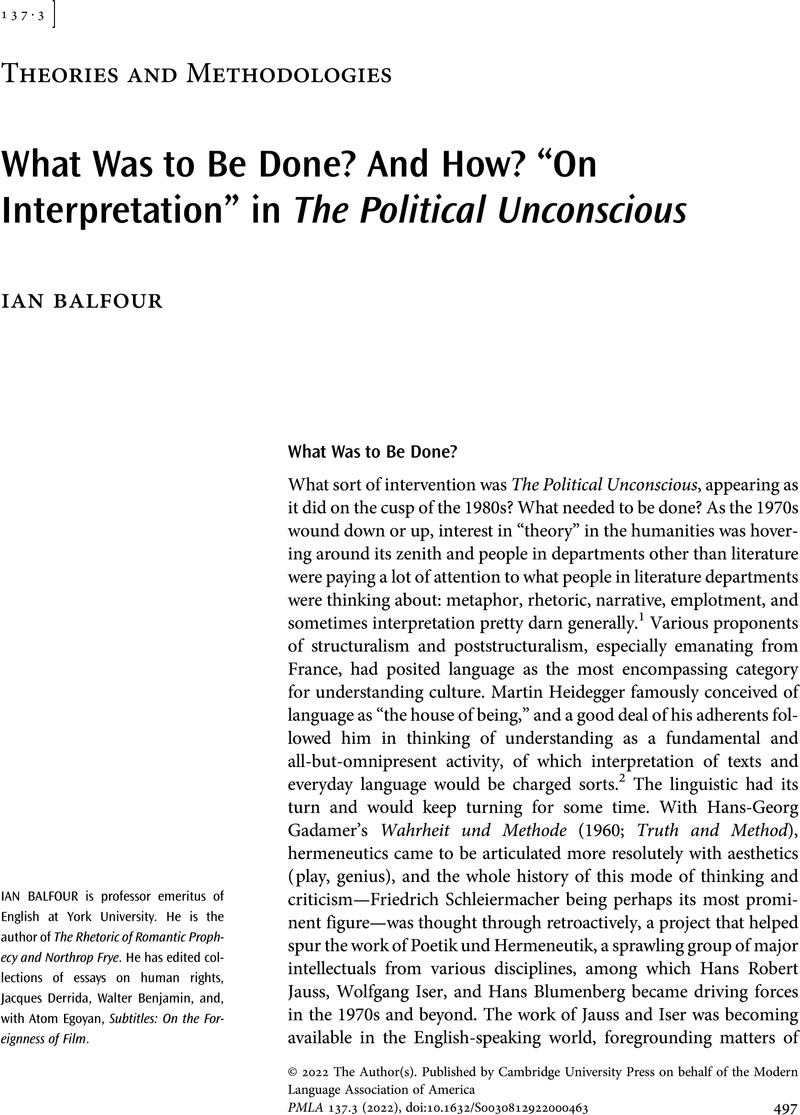No CrossRef data available.
Article contents
What Was to Be Done? And How? “On Interpretation” in The Political Unconscious
Published online by Cambridge University Press: 28 July 2022
Abstract
An abstract is not available for this content so a preview has been provided. Please use the Get access link above for information on how to access this content.

Information
- Type
- Theories and Methodologies
- Information
- Copyright
- Copyright © 2022 The Author(s). Published by Cambridge University Press on behalf of the Modern Language Association of America
References
Works Cited
Benjamin, Walter. “On the Concept of History.” Selected Writings: Volume 4: 1938–1940, edited by Eiland, Howard and Jennings, Michael W., Harvard UP, 2003, pp. 389–400.Google Scholar
Benjamin, Walter. “Paralipomena to ‘On the Concept of History.’” Selected Writings: Volume 4: 1938–1940, edited by Eiland, Howard and Jennings, Michael W., Harvard UP, 2003, pp. 401–11.Google Scholar
Blumenberg, Hans. History, Metaphors, Fables: A Hans Blumenberg Reader. Translated by Bajohr, Hannes, et al. , Cornell UP, 2020.Google Scholar
Butler, Judith, et al. Contingency, Hegemony, and Universality: Contemporary Dialogues on the Left. Verso, 2000.Google Scholar
Comay, Rebecca, and Ruda, Frank. The Dash—The Other Side of Absolute Knowing. MIT Press, 2018.CrossRefGoogle Scholar
Dilthey, Wilhelm. “The Rise of Hermeneutics.” Translated by Fredric Jameson. New Literary History, vol. 3, no. 2, 1972, pp. 229–44.CrossRefGoogle Scholar
Hegel, G. W. F. Vorlesungen über die Philosophie der Geschichte. Werke in zwanzig Bänden, vol. 12, Suhrkamp, 1976.Google Scholar
Jameson, Fredric. Late Marxism: Adorno; or, The Persistence of the Dialectic. Verso, 1990.Google Scholar
Jameson, Fredric. Marxism and Form: Twentieth-Century Dialectical Theories of Literature. Princeton UP, 1971.Google Scholar
Jameson, Fredric. The Political Unconscious: Narrative as a Socially Symbolic Act. Cornell UP, 1981.Google Scholar
Jameson, Fredric. The Prison-House of Language: A Critical Account of Structuralism and Russian Formalism. Princeton UP, 1972.CrossRefGoogle Scholar
Nietzsche, Friedrich. Dawn: Thoughts on the Presumptions of Morality. Translated by Smith, Brittain, Stanford UP, 2011. Vol. 5 of The Complete Works of Friedrich Nietzsche.Google Scholar
Nietzsche, Friedrich. Nachgelassene Fragmente. Sämtliche Werke, vol. 12, edited by Colli, Giorgio and Montinari, Mazzino, Deutscher Taschenbuch Verlag, 1980.Google Scholar
Robbins, Bruce. “Single? Great? Collective? On Allegory and Ideology.” South Atlantic Quarterly, vol. 119, no. 4, 2020, pp. 789–98.CrossRefGoogle Scholar
Sartre, Jean-Paul. Critique of Dialectical Reason. Vol. 1, translated by Smith, Alan Sheridan, Verso, 2004.Google Scholar
Szondi, Peter. An Introduction to Literary Hermeneutics. Translated by Wodmansee, Martha, Cambridge UP, 1995.CrossRefGoogle Scholar
Szondi, Peter. On Textual Understanding. Translated by Mendelsohn, Harvey, U of Minnesota P, 1996.Google Scholar

